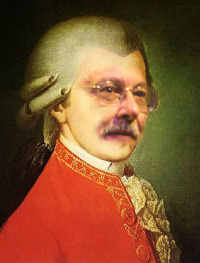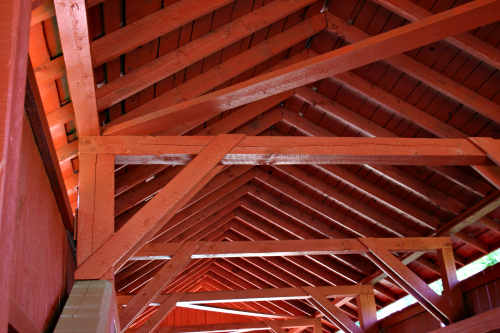A 365-Day Project
"We Are All Mozart"
A project to create
new works and change
the perception of the
music of our time.


 August 27, 2006
August 27, 2006 
Yesterday, John Weinzweig's obituary reported the comments of Weinzweig biographer Elaine Keillor. "He drew hostile reactions from audiences and Canada's reigning musical establishment over his use of the modern serial technique, Keillor said. It took years of work to overcome that hostility, she said." In response, another composer wrote, "It sounds as though Mr. Weinzweig simply wore audiences down by continuing to force-feed them music that 'drew hostile reactions' rather than understanding that, perhaps, there was no need to injure the ears and sensibilities of his paying customers."
From her words, it seemed evident that the latter composer was among the younger composers -- and indeed, she was born in 1970. But knowing this composer, I respect her points of view, and wanted to take a listen to Weinzweig's music again.
There is the Canadian Music Center's two-CD set (with a third CD that is a documentary portrait) of Weinzweig that came out four years ago (CMCCD 8002). It includes Symphonic Ode (1958), Dummiyah (1969), Concerto for Harp & Chamber Orchestra (1967), Violin Concerto (1954), String Quartet No. 3 (1962), Woodwind Quintet (1964) and Pieces of Five (1976).
This is a fair sample of Weinzweig's coloristic diversity, but unfortunately not a wide enough look at his work, which spans the 1930s through the 1990s. The recorded compositions sometimes show Weinzweig at his hardest-line, and just moving toward a softening by the 1970s. Nevertheless, from the perspective of 2006, there is nothing at all unlistenable about them, and it seems odd that this confrontational aspect is still emphasized at all.
On the other hand, I admit to knowing nothing about Canadian music of the 1940s through 1960s. Canadian culture never penetrated south to New Jersey, where my initial artistic development took place. I do know the concert scene then (and it is only changing today) was far less developed than that in the U.S. much less Europe, and probably was a heavily conservative audience. To them -- and without the benefit of our hindsight twenty and thirty and seventy years out -- Weinzweig could have sounded incredibly confrontational.
Symphonic Ode and Dummiyah are both orchestral, and startlingly different. The former is quite lush. Whatever 12-tone structure it may use is certainly overwhelmed by the Berg-like compositional lyricism (just as Berg overwhelmed the structural character in his writing), from the moment it rises out of the low strings, through wind commentaries and into a Bartók-like shape that give it an immediate sense of unity and contrast that work effectively together. The solos are placed jaggedly, but are themselves liquid and consistently 'un-leapy' for modernist composition. What I am noticing (and my commentary on Adorno makes this point as well) is that modernist music is, compared to the music of the past thirty years, surprisingly romantic in character -- much more than it seemed coming through its late stages to this nascent composer. As Ode builds to a climax, its architectural feel is more akin to Mahler than the supposed twelve-tone revolution that followed. It is clearly the end of an era peeking through this composition.
By contrast, Dummiyah is almost spectral in nature, looking forward almost a decade -- marvelous pianissimo masses of strings in microtones, and colorful, complex and fluttery wind solos rising out of the interstices. The texture thins and thickens, with a langorous development and frequent patches of silence or near-inaudibility, and ending indecisively with a massed chord and more silence. The work is captivating in its clear denial of the angular textures of earlier works.
The Concerto for Harp & Chamber Orchestra is a virtuoso piece, and would never be confused with the blushing anonymity Mozart offers the instrument, instead pushing an aggressive re-thinking of the harp as anything but a gentle confectionary sound. Based on the leaps and effects and intensity, it was probably a great sight as well as a fine listen. The jaggedness of the melodies and the interplay of soloist and the chamber soloists mark it with the Klangfarbenmelodie stamp, but Weinzweig is not didactic or confrontational in its use, preferring to let the harp lead the strings and thus modify their character. What is especially interesting is how different this concerto is from Dummiyah, which followed it by just two years.
Most difficult is the polemical and technically demanding Violin Concerto. It contains all the hallmarks of modernism -- astringent melody, unassessable rhythms (from a listener's viewpoint), and sometimes the kind of flat contours that serial music presents, with all elements equally present in the time and texture. But conversely it has an orchestral handling that is almost Shostakovich-like in its way of underscoring melodic and harmonic importance with stacked octaves and homophonic textures, particularly in the second movement. Overall, though, it presents the strongest evidence of being product of its time (1954) and engendering the common hostility toward all the most corrosive mid-century serial compositions.
Now here's a problem with the concerto (and the others on this set as well), and one I've alluded to in earlier commentaries. The Weinzweig recordings all appear to be performances done about the time of the compositions themselves (no recording information is given), and as such do not reflect the level of understanding that time and repetition (not to mention a new generation of performers) will bring to work. These recordings of Weinzweig are what I call "big elbows" performances, exaggerating the gestures to imprint them on performer and audience. A leap is leapier, an accent more biting, a dissonance edgier, a silence more aggressive. There is something sharp and poking about them, because the genre was then not as natural, not as self-evident, as it feels today, when performers are able to bring what we often call a 'musical' character to the composition. We have moved past those styles, and can now play and hear them in context, with understanding and sensitivity.
Back to the pieces. The String Quartet is definitely jagged. Weinzweig (like so many of us, I think) see the string quartet as the pinnacle of chamber music, the ensemble most demanding to write for and out of which the most definitive compositional statement is expected (we are all in the shadow of Haydn, Beethoven, Bartók and Shostakovich). This is a half-hour, five-movement quartet which has plenty of time to develop its ideas, which it does so by moving increasingly away from the quasi-harmonic sweetness of the opening movement; the second movement sounds like George Rochberg of the same pre-new-romantic era, though with more politeness or refinement, so to speak. The third movement is unfortunately marred by the cliché of modernist melody, passionately recusing itself from harmonic intervalic motion. And so it goes, until the Kol Nidre last movement which retracts the 'big elbows' in favor of delicacy and quiet passion.
Perhaps woodwinds get along best with serialism. I recall Carter's marvelous Eight Études for winds, for example, or even a recorded demonstration on Folkways records -- was it Vaclav Nelhybel? -- of building a serial piece with woodwinds. Weinzweig's Woodwind Quintet has the same techniques as the String Quartet, but the winds give it a characteristic (as they do in Dummiyah) that is 'wholesome' and open-faced. It is, perhaps, that winds are less prone to romanticism and thus do not compete with the atonal structure as would the heavy-breathing violinist.
The final Pieces of Five are played by the Canadian Brass. I have no idea how this relationship came about, but the Brass aren't even technically up to the piece (repeatedly staggering the rhythms and clamming pitches in the opening), much less psychologically. This could be an interesting composition, but one cannot tell from the recording -- in any case, it's very colorful but at 20 minutes too long for the color alone to carry it, particularly in the hands of the Canadian Brass, who seem distinctly unenthusiastic.
In sum, Elaine Keillor's comments are probably correct, but again, from a 2006 perspective, the music sounds a tad quaint and actually appealing. We do not hear much of this style anymore, and having had a generation-long tonal "vacation", so to speak, I think it's worth re-approaching this music. In Weinzweig's case it is brilliantly written, and that alone is enough for giving it a new stage -- maybe not today, but 20 years in the future, when the ugly behavior of the 20th century musical community is forgotten. Rediscovering these styles in the early Adorno and the late Weinzweig over the past week or so has been more rewarding than I had expected, and like the unlistenable music of the Ars Nova, I think at some point -- when all of us have joined Weinzweig in the grave -- there will be an epiphany about Modernism.

Slaughterhouse Bridge in Northfield Falls is just down the tracks. The interior structure looks like modernism sounds. This look appeals, and years from know, so will the erstwhile style of Weinzweig.